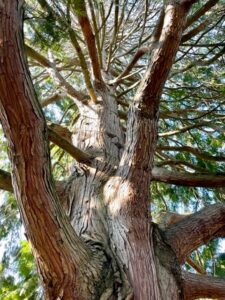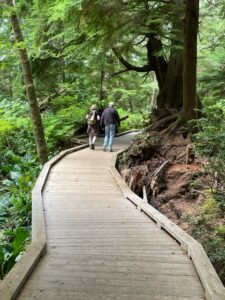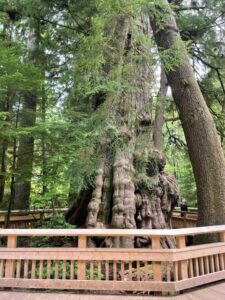 We’ve got a nice Western Redcedar next door, and Anna takes great care of it. She has a nearly untoward fondness for trees and I’m sure they think the world of her too. I’d have to do some basic math to figure out how tall it is and I left my math in my other pants, but it’s respectable. It was big when we bought our place and that was 45 years ago. We worry about it now because so many of our conifers have suffered from drought and some were killed outright by three consecutive days of stupid heat last year. According to Anna, the word on the street is our native Western Redcedars are in rapid decline.
We’ve got a nice Western Redcedar next door, and Anna takes great care of it. She has a nearly untoward fondness for trees and I’m sure they think the world of her too. I’d have to do some basic math to figure out how tall it is and I left my math in my other pants, but it’s respectable. It was big when we bought our place and that was 45 years ago. We worry about it now because so many of our conifers have suffered from drought and some were killed outright by three consecutive days of stupid heat last year. According to Anna, the word on the street is our native Western Redcedars are in rapid decline.
So when our friend Margie offered to show us the biggest such cedar anywhere, we jumped at the chance. It had the air of a pilgrimage. Maybe if we admired it hard enough, it would put in a good word for its junior cousin next door. The big tree is located in a major bogland at the ocean’s edge, and I love bogs. There’s a half-mile trail to it.
 The trail is remarkable. It is a boardwalk constructed with great care and it keeps tree and bog admirers out of the muck the whole way. I usually look askance at such things. It feels as though if you make it too easy for people to go look at wonderful things, people will go look at wonderful things, and I’d rather have the things to myself. Screw those wheelchair folks, say I, though not loud enough to be caught saying it. There’s nothing I like better than walking somewhere beautiful, and the more rooty and rocky and exposed and steep and far away it is, the more likely it is we’ll have the prize more or less to ourselves. And we won’t have to listen to some bozo loudly telling his kids something about nature that is totally untrue.
The trail is remarkable. It is a boardwalk constructed with great care and it keeps tree and bog admirers out of the muck the whole way. I usually look askance at such things. It feels as though if you make it too easy for people to go look at wonderful things, people will go look at wonderful things, and I’d rather have the things to myself. Screw those wheelchair folks, say I, though not loud enough to be caught saying it. There’s nothing I like better than walking somewhere beautiful, and the more rooty and rocky and exposed and steep and far away it is, the more likely it is we’ll have the prize more or less to ourselves. And we won’t have to listen to some bozo loudly telling his kids something about nature that is totally untrue.
In other words, I’m a butt. But the thing about wilderness is the more people who want to be in it, the less of it you have.
This particular boardwalk was itself a thing of beauty, though. The planks at curves were meticulously cut into fans. All around it rose skunk cabbage leaves that would not be out of place on a queen-size bed. Steller’s jays, crows, and wrens made periodic announcements and woodpeckers were in charge of maintenance. And then we came to the tree. This thing has been assembling itself for a very long time.
 “So, is this the oldest cedar tree ever?” It looked possible.
“So, is this the oldest cedar tree ever?” It looked possible.
“Dang it,” Margie complained, “there should be a plaque. Where’s the plaque?”
No plaque. Just a beautiful boardwalk encircling the tree at a respectful distance, and a bench or two. So how old would the oldest cedar tree be?
According to one source, this Rockaway Cedar is between 500-900 years old. That’s cutting yourself a lot of leeway, I think, but nobody is in a hurry to do any ring-counting. However, it’s not the biggest in the world. It’s not even the biggest in Oregon.
There are several in contention. There’s the Quinault giant. The Kalaloch Big Cedar. It’s hard even to estimate size. At that age, the trees are lumpy and weird. It’s like sectioning a mutant broccoli. Do you count the tallest or the fattest? The Duncan Memorial Cedar is the biggest of all time! The Cheewhat on Vancouver Island is also the biggest of all time! It’s like asking a bunch of experts at the local tavern what the best baseball team is. No wonder our poor giant doesn’t get a plaque:
Big Rockaway Cedar
Don’t Even Ask
Age is tough to work out too. Depending on which page of the internet you land on, the Quinault Giant is a thousand years old or two thousand years old. The Cheewhat might be 2,500 years old. Also, it might not. People get fancy with this. According to one source, “the Kalaloch Big Cedar Tree has been standing in the same location since the Byzantine Empire ruled Constantinople.” No one knows where it was before that and the Macedonians aren’t saying.
The Duncan Cedar was named after a logger who discovered it and didn’t get around to bringing it down. It could be he was overcome by its majesty although that sort of reluctance to fell is not common in the logging world, where the recent drop in the harvest of old-growth timber is now attributed to the scarcity of old-growth timber to harvest. Still, Duncan left it be, and good on him.
What is known is the Pacific Northwest coast is great for ancient huge redcedar trees. They love water and we have water. At least we’ve always had water, even in living human memory, and plenty of damp people would stake their reputations on the idea that we still do, but things have changed. Unfortunately, legacy water doesn’t do much for living trees. Even incremental increases in temperature and moisture seem to put these ancient giants into a pout. Nothing more temperamental than a thousand-year-old tree, I always say. They’re cranky and set in their ways, and they need to smarten up or step aside for a nice neat privet hedge. We’ve got new ways now.
It’s tempting to look at all of these giants as botanical timelines of modern humanity. Let’s say for the sake of argument they all came in with Jesus. Maybe he rose again, but they just kept on rising. The sky appeared to be the limit. But uh-oh! Things are taking a turn. There’s heat stress from climate change. There are stronger storms.
The Kalaloch Big Cedar keeled over in a wind in 2014. The Quinault Giant dropped dead in 2016. The trampling feet of its admirers in the root zone is also thought to be a factor in its demise.
That boardwalk is looking more beautiful all the time.
What a grand day out! We go on holiday to see trees, not specific ones, just trees in general. Here in Orkney, trees are limited in height by prevailing winds, so only grow as much as any shelter allows, be they in the lee of a rock, other trees, a fence or a house. Dwarf Willow and Creeping Willow are very popular! Autumn colour? Forget it, it was Summer when I began that last sentence, and Winter by the time I typed the question mark.
As a Creeping Dwarf myself, I approve this comment.
In various woods that I’ve hiked in, there have always been special trees that I make it a point to visit. In one state park, there is a tremendous old oak in a clearing. In another park there are two trees that have grown together as one tree. In a nearby development, there was an old oak that predated the homes built around it. I like that they deliberately built around this tree rather than seeing it as an obstacle. Sadly, it was struck by lightning one year. I still have a small chip from it, and they planted another oak in the same spot. My own home is surrounded by trees, some that I planted, and some that were planted by squirrels. I only cull the saplings that are under power lines or too close to the house. I mourn every tree that we must have taken down because it is leaning toward the house. (Too much rain in recent years had lifted their roots up.) An ice storm several years back sheared off the entire north side of our pines. Even when my neighbor (who I love) has trees cut, I cry and curse about it (not to her. As I said, she is a wonderful neighbor otherwise.)
I’m triggered by the sound of chain saws.
Yeah… me, too. I’m like what mofo is cutting down a tree??? I’ve read that the smell that we associate with grass being mowed is actually how they communicate to other grass… kind of a distress call. Although, since they can’t very well move from their location, I don’t know what good it does. So now, when I smell grass being cut, it makes me sad, but there is absolutely nothing I can do about it. So grass is just messin’ with me!
That is a very beautiful boardwalk! There should be more of them to keep trampling feet away from what is precious.
I didn’t do it justice with the photos.
Murr, you might not know that the entrance to this boardwalk is across 101 as the crow flies from my beach house. I absolutely love the new boardwalk, my favorite early morning walk when I’m there. I’d be happy to take you on the other unnamed foot trodden path through the muck that we used before the boardwalk was built. I’ll be there in a few weeks.
Me , too?
I did know that! I realized right away that Saltair was right across the street. I won’t be able to get out there anytime soon. I suppose you mean the footpath that ends up at the tree? We didn’t take that–heard it was a little mucky. But I will some day. Take Jimmy! ^^
I love your comment about no one knowing where a tree was before the Byzantines. I needed the laugh.
My brother and I hiked to the Pacific Ocean in Washington State a few times via a boardwalk. That thing had more twists in it than a snake with a bellyache. We tried to figure out the thinking behind it and gave up. Some twists might be attributable to grade concessions, but others just seemed to be curving for no reason. Maybe installer was being paid by footage.
In the Olympics, I assume?
My Dad died aged 82 in 1986. The last house my folks lived in was shaded by an enormous White Oak that he’d eaten lunch under as a teenager, working his first job. It was just as big then, as far as he could tell. The grandkids would make a game of seeing how many kids it took to reach around its trunk, generally five or six, depending on the age and size of the kid. A few years back there was a prolonged drought in East Texas. ‘Dad’s Tree’ died, and after it dropped a big branch on the nephew’s truck who’d inherited the property they decided to cut it down. It was 400 years old, according to the guy that cut the rings. Just a sapling compared to the cedars along the Pacific NW, but it hurt my heart to lose that tree just the same.
I didn’t know that tree personally, but I teared up about it dying. Not about your dad, mind you; he was 82, and as far as I can tell it all goes downhill pretty fast after that, if not before. But 400 is, I would think, only middle-aged for an oak. I used to admire The Salem Oak in Salem, New Jersey, just across from the Salem Oak diner. Paul and I would go there for breakfast on our way to Cape May. (I know that you hail from this area, so you may have known of that tree.) It was struck by lightning a ways back and died. It was estimated to be between 500 and 600 years old at the time (2019).
Hurts my heart just hearing about it, Deb. And mimim.
Thank you, Murr, for another lovely piece!
Now as for cedars, my favorite walking stick is of cedar, which I got to smell (mmmm!) when I drilled a hole in it to thread a strap through. Then I looked up cedar and was told that what North Americans call cedar is actually a juniper. Today I looked up Red Cedar and found that it is a name given to:
-Toona ciliata, a tree in the mahogany family native to Asia and Australia
-Toona sureni, a tree in the mahogany family native from South Asia to Papua New Guinea
-Juniperus virginiana, an eastern North American juniper
-Juniperus procera, an East African juniper
-Thuja plicata, a western North American tree in the cypress family
So I looked up “aromatic cedar,” the yummy-smelling stuff, and the internet told me it is Juniperus virginia. Because of where you live, I will venture a guess that your Red Cedars are Thuja plicata, but don’t quote me. May I quote you? (Don’t ask me which words, I haven’t decided yet.)
You may quote me anytime, and hear this: Western redcedar is indeed Thuja plicata, and not a true cedar at all.
There is an ancient bald cypress tree in the Seven Sisters swamp in North Carolina. You need a canoe or a kayak. It’s awesome.
I’ve been to the Outer Banks of N. Carolina. I wonder if they’re still there?
I have to concur. There are too many people and not enough trees. Hopefully the Rapture will come along soon and relieve us of some of the excess. We can deal with the laundry they leave behind. Or do their clothes rapture too? Always wondered about that.
I wish I had been as much of a smartass back in Catholic grade school as I am now. I used to ask the nuns perplexing questions (“Sister? If Adam and Eve had 3 sons, how did they produce children?” She was visibly flabbergasted and changed the subject very quickly.) The Rapture question would have been a great question to ask!
I hope they at least get to keep their underpants. I don’t want to be looking up at all that.
I’m just reading a book that explains how these giants get their drink of water – https://www.goodreads.com/book/show/35187175-storm-in-a-teacup
I haven’t read it, but I’ll bet some of those coastal redwoods slurp it right out of the air.
IIRC, the fog condensate drips from their needles and lands on the ground around their trunks. Gotta have fog.
While I haven’t been in years, there was a very large cedar east of Tillamook, up the Trask river, a few miles up and a couple hundred feet to the north of the road up the river. I used to fish there frequently in the early 70’s, and noticed some of the ribbons used to mark future logging work. I and a couple others took to taking them all down every time we were there. I continued for a year, then they (whoever ‘they’ were) stopped putting them up. A small victory, maybe Ed Abby would have approved.
I guess you must be the artist formerly known as “should fish more” Mike. Way to go, taking down the ribbons! I try to be a little more anarchic than the average person, but sometimes, I go a little too far (especially in my language. People seem to be offended mostly by that. WTF??? Yes, I AM rude and crude. So what, bitch???)
Well I approve! That and $4.75’ll get you a cup of coffee…